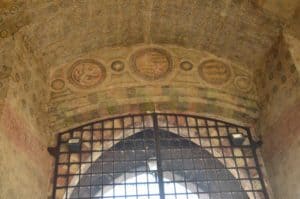Last updated on .
After we finished our visit to the Castle of Saint George, we walked over to the entrance of the Old Court (Corte Vecchia) of the Ducal Palace (Palazzo Ducale). It makes up the oldest part of the palace dating back to the late 13th century. We immediately noticed the Gonzaga coat of arms above an entrance.

First Rooms
The beginning of our self-guided tour took us through a couple rooms of the palace containing some frescoed walls and ornate wooden ceilings. There were a few artifacts and paintings on display in these rooms.
Next, we walked through the Hall of the Emperors (Sala degli Imperatori), the Pisanello Room (Sala del Pisanello), and the Hall of Popes (Sala dei Papi). The Pisanello Room has a large fresco by Pisanello depicting Louvezerp’s Tournament-Battle. It was painted between 1436 and 1444, whitewashed, and rediscovered in 1969. The Hall of Popes contains a preparatory drawing by Pisanello on the wall.
New Gallery
Several paintings were on display in the New Gallery (Galleria Nuova) which followed. The room was constructed in 1778 by Italian architect Giuseppe Piermarini to connect two parts of the palace.
Hall of Archers
In the Hall of Archers (Sala degli Arcieri), there were a few large paintings on display that used to belong to churches and monasteries. One of them is an altarpiece by Peter Paul Rubens, The Gonzaga Family in Adoration of the Holy Trinity (1604). The ceiling of that room has a fresco depicting a cloudy sky.
Hall of Mirrors
The Hall of Archers opens to the Hall of Mirrors (Galleria degli Specchi), which was built by Vincenzo I Gonzaga in the late 16th century. The frescoes were painted by Antonio Maria Viani while some other decorations were added in 1773.
Private Apartments
Next, we walked through the Hall of Judith (Sala di Giuditta), the Labyrinth Room (Sala del Labirinto), and the Crucible Room (Sala del Crogiolo). The Labyrinth Room contains a labyrinth carved into the ceiling that was transferred from the Palazzo San Sebastiano. It commemorates the Battle of Kanizsa in Hungary, where Vincenzo I fought against the Ottomans. The Hall of Judith and Crucible Room have identical ceilings.
Our visit continued through the Corridor of the Moors (Corridoio dei Mori), a hallway which contains frescoes on the ceiling.
We then walked through the Lodge of Santa Barbara (Loggetta di Santa Barbara) and the Changing Room of the Moors (Camerino dei Mori) before entering the Hall of the Falcons (Sala dei Falconi).
Zodiac Room
The Zodiac Room (Sala dello Zodiaco) was the bedroom of Guglielmo Gonzaga and one of the most interesting rooms in the palace. It has an astronomical fresco of Diana’s chariot pulled by dogs among the constellations painted on the ceiling by Lorenzo Costa the Younger in 1579. The room also served as Napoleon’s bedroom during the Napoleonic Wars.
Hall of the Rivers
From the Zodiac Room we visited the Hall of the Rivers (Sala dei Fiumi). This room was once a refectory but was refurbished under Habsburg rule. It portrays all the rivers in Mantuan territory as giants and has a grotto with an urn at each end.
Apartments of the Tapestries
Finally, we finished with some of the most impressive rooms in the palace, the Apartments of the Tapestries (Stanze dell’Appartamento degli Arazzi). They consist of three rooms containing tapestries and a small hallway.
The tapestries, which depict the Acts of the Apostles, were made in Flanders based on drawings by Raphael. They were purchased around 1557 by Cardinal Ercole Gonzaga to decorate the Palatine Church of Santa Barbara (the palace chapel), later ending up in storage. The tapestries were restored and placed in their current locations in 1799.